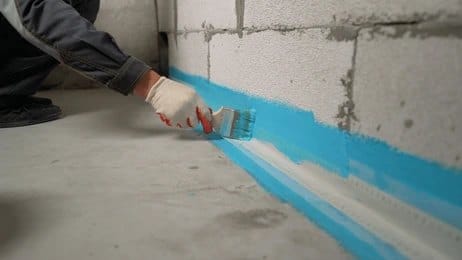Let’s get straight to it.
Leaks are stealthy. They don’t shout. They whisper. A tiny stain here. A peeling wall there. A faint fragrance you can’t place. Before you know it, your pristine wall looks like it’s gone through a storm.
Now here’s the deal. Most individuals recognize the problem after it occurred.
And that’s exactly what makes waterproofing materials so crucial. They stop harm before it starts.
🧱 The Real Problem: Water Doesn’t Wait
If you live in a city with unpredictable rainfall or humid air, you’ve probably seen it happen.
You build something nice. It looks wonderful for a few months.
Then suddenly—paint bubbles, tiles move, plaster fractures. Why? Because water got in.
Water always finds a way. Through hairline fissures. Through weak corners. Through that one location everyone believed was “fine.”
Ignoring waterproofing is like locking your house and leaving the back door wide open.
💡 So What’s the Solution?
It's simple: employ the correct waterproofing materials from the start.
But hold on.
It’s not only what you use. It’s how you utilize it. And where.
That’s when professional contractors like Artscape Developers home construction company in Bangalore step in. They don’t just put on a layer and call it waterproofing. They develop protection with precision, timing, and care.
They ask: What kind of space is this? What material is suitable for this wall or floor? How much water exposure will it get?
Those tiny inquiries make a tremendous difference.
🔍 A Quick Look at Waterproofing Materials That Actually Work
Let’s keep it clear. Here are some of the most prevalent waterproofing materials—and what they’re ideal for:
#1. Cementitious Waterproofing
Good for: Toilets, kitchens, basements
Looks like: A gray slurry mix
Why use it: Easy to apply. Bonds well with concrete.
#2. Bituminous Coating (Asphalt Layer)
Good for: Foundations, under-tile spaces
Looks like: Thick black tar
Why use it: Blocks water effectively. Works nicely under slabs.
#3. Bituminous Membrane
Ideal for: Roofs, terraces
Looks like: Thick rolls or sheets
Why use it: Strong, durable, ideal for huge areas.
#4. Liquid Waterproofing Membrane
Good for: Small or oddly-shaped areas
Looks like: Paint, but turns rubbery when dry
Why use it: Flexible. Easy to apply around curves and edges.
#5. Polyurethane Liquid Membrane
Good for: Flat roofs with long sun exposure
Looks like: Glossy, thick paint
Why use it: UV-resistant. Long-lasting.
📍 Where Should You Use Waterproofing?
Pretty nearly every surface exposed to wet needs some type of waterproofing.
Here’s a quick list:
Roofs
Terraces and balconies
Basements
External walls
Bathrooms and toilets
Kitchens
Planter boxes
Water tanks
Swimming pools
Parking decks
Each of these demands a different type of material. And different treatment.
That’s why no skilled builder utilizes a “one-size-fits-all” waterproofing solution.
🧠 Why People Mess This Up (And How to Avoid It)
Most waterproofing failures happen because someone omitted a step. Or utilized the wrong material. Or worse—used the right material but applied it incorrectly.
Here’s what often goes wrong:
Surface wasn’t clean before applying
Primer was skipped
Waterproof layer was too thin
Second coat added too early
Edges and seams weren’t sealed properly
Drainage slope wasn’t considered
You don’t need a PhD to get this correctly. You just need a builder who doesn’t rush through it.
Artscape Developers treats waterproofing like it deserves attention—because it does.
🔧 How Artscape Developers Get Waterproofing Right
Here’s how pros manage it:
1. Inspect the Surface
No concealed cracks. No leftover dust. Clean, even surfaces only.
2. Choose the Right Material
They don’t guess. They pick based on moisture, sunlight, usage, and surface.
3. Apply in Layers
One layer isn’t enough. They build it up properly with time in between.
4. Seal the Joints
Corners, drainpipes, edges—these are the difficulty locations. They pay particular care here.
5. Test Before Closing the Area
Before tiles, flooring, or paint go in, they run a test. This ensures zero surprises later.
💰 Is Waterproofing Expensive?
No.
Fixing leaks is expensive.
Removing mold. Repainting walls. Replacing tiles. Redoing ceilings.
Compared to that, waterproofing is cheap.
Here's a rough idea:
Bathroom waterproofing: Starting at ₹3,000–₹5,000
Terrace: ₹20–₹50 per sq ft
Basement: ₹80–₹120 per sq ft
External walls: ₹30–₹60 per sq ft
Costs depend on material and locality. But it's always less than repairs.
📝 Waterproofing Checklist: What to Ask Before Starting
✅ What locations need waterproofing?
✅ What kind of material will be used?
✅ How many coats will be applied?
✅ How long will it take to cure?
✅ Will there be an exam following application?
✅ What is the warranty on the work?
These questions help avoid surprises later.
And you’ll get direct responses from brands like Artscape Developers—because they’ve done this hundreds of times.
🤔 FAQs About Waterproofing Materials
Q: Can I waterproof a wall that’s already leaking?
Yes—but first, the leak needs to be addressed at the root. Then proper waterproofing can be done.
Q: How long does waterproofing last?
Most systems survive 8–10 years. Longer, if it’s applied carefully and maintained.
Q: Can I DIY this?
Small areas—maybe. But bathrooms, basements, or terraces? Always better to hire a pro.
Q: Does waterproofing smell or release fumes?
Some coatings do during application, especially solvent-based ones. Good ventilation helps.
🎯 Final Thoughts: Don’t Let Water Win
You may not see it every day. But waterproofing is working every second.
It’s keeping your home safe. Dry. Healthy.
A healthy foundation deserves good protection. And that starts with the appropriate materials—and the right people applying them.
Artscape Developers doesn’t only develop spaces. They protect what matters inside them.
That’s the difference between a house that lasts—and one that’s continually being fixed.
Choose wisely. Build strong. Stay dry.
To know more, visit our website Artscape Developers or call us at
+91 9880170976

